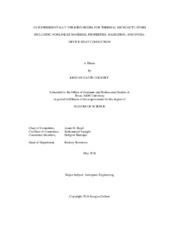| dc.description.abstract | A multi-physics model and computational method is presented for predicting the performance of thermal microactuators at high input powers. The model accounts for nonlinear temperature dependence of material properties, heat loss due to radiation, and intra-device heat transfer by conduction across an air gap. To solve the highly nonlinear governing heat equations and compute the temperature distribution in the actuator, the Galerkin method with Newton-Raphson iteration is employed, enabling the calculation of device displacement. To verify accuracy, the model is applied to the case of a flexure actuator operating at steady state, and model predictions are compared with experimental voltage, current, and displacement measurements. To investigate the effects of each nonlinearity in the model, the predictions of six additional hypothetical models are considered in which (1) intra-device heat transfer is neglected, (2) heat loss due to radiation is neglected, (3) the thermal conductivity of silicon is assumed to be temperature-independent, (4) the thermal conductivity of air is assumed to be temperature-independent, (5) the electrical resistivity of silicon is assumed to be a linear function of temperature, and (6) the thermal expansion coefficient of silicon is assumed to be temperature-independent. With the exception of heat transfer due to radiation, each source of non-linearity was shown to have a significant impact on the accuracy of model predictions at high electrical power input. The model is further applied to predict the dynamic performance of the flexure actuator using an implicit Euler method to predict the evolution of the temperature distribution over time. The dynamic implementation is then used to calculate the thermal time constant for the flexure actuator, and model predictions for the transient voltage-current response are verified experimentally. | en |


